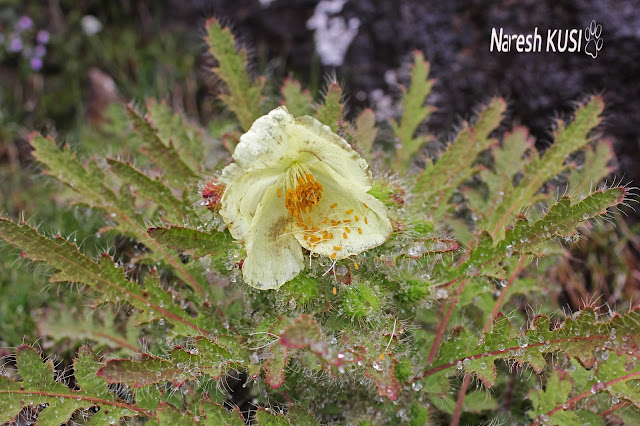Wednesday, June 17, 2015
जाने होइन त लिमी?
गत बैशाख १२ गतेको
महाभुकम्प र त्यसपछि लगातार आइरहेका पराकम्पहरुले नेपालका चल्तीका पर्यटकीय
गन्तव्यहरुमा नराम्ररी असर गरेको छ। लाङ्टाङ् गाउँको नक्सानै बदलिएको छ,
मनास्लु पदमार्ग बिग्रिएको छ, सगरमाथा आधारशिबिर जाने बाटोमा थुप्रै होटलहरु
भत्केका छन् र अन्नपुर्ण पदयात्रा अन्तर्गतको जोमसोम खण्डमा पनि संरचनाहरु
भत्किएका छन्। खुम्बुतिर
पुननिर्माणको काम सुरु भैसकेको भएपनि लाङ्टाङ् र मनास्लु पदमार्गको पुननिर्माण हुन
केहि वर्ष पक्कै लाग्नेछ। बर्षा यामसंगै
आउन सक्ने पहिरोको जोखिमका कारण अन्नपुर्ण पदयात्रा पनि केहि समयको लागि
पर्यटकहरुको आकर्षणबाट बिमुख हुने देखिन्छ।
नेपालको
पश्चिमान्चल, मध्यमान्चल र पुर्वान्चलका पर्यटकीय गन्तव्यहरु केहि सुस्ताएको अवस्थामा
अब मध्यपश्चिमान्चल र सुदूरपश्चिमान्चलका पर्यटकीय गन्तव्यहरुको प्रवर्धन गर्न
आवश्यक छ। बर्षौ राज्यले बेवास्ता
गरेको कर्णाली अहिले जोसिएर प्रस्तुत हुनसके यहाँ दीर्घकालिन पर्यटनको ढोका
खुल्नेछ। पर्यटन व्यवसायीहरुले पनि
यतातिर ध्यान दिँदा राम्रै होला!
मध्यपश्चिमान्चलको
हुम्ला जिल्लामा अवस्थित लिमी उपत्यका भरपुर पर्यटकीय सम्भावना बोकेको ठाउँ हो। काठमाडौँबाट नेपालगंज अथवा सुर्खेतहुँदै
हवाईमार्गबाट हुम्लाको सदरमुकाम सिमिकोट झरेपछि सुरु हुन्छ लिमी उपत्यकातिरको
रोमान्चक यात्रा। समुद्री
सतहबाट ३००१ मि. उचाईमा अवस्थित सिमिकोट नेपालकै सबभन्दा अग्लो स्थानमा रहेको
सदरमुकाम हो।
सिमिकोटबाट
डाँडाफोया-धारापोरी-केर्मी-ओखरथला हुँदै सल्लीडाँडा पुगेपछि नारा लाग्ना (४५६७
मि.) र न्यालु लाग्नाको (५०१० मि.) बाटो छुटिन्छ। जुन महिनाको अन्तसम्म पनि न्यालु लाग्नामा हिउँ
हुने भएकाले नारा लाग्नाको बाटो बढि प्रयोगमा आउँछ।
सल्लीडाँडाबाट सल्लीखोला-याल्बांग-मुचु-यारी
हुँदै नारा लाग्ना काटेर हिल्सा (३६५९ मि.) गाउँमा पुगिन्छ। हिल्सा नेपाल-तिब्बत सिमानामा अवस्थित गाउँ हो। यहाँबाट नजिकैको तिब्बती भूभाग देखिन्छ।
हिल्साबाट नामका लाग्ना (४५७८ मि.) नपुगुन्जेल
उकाली ओरालीको बाटो भएर जानुपर्छ। नामका लाग्ना कटिसकेपछि लिमी गाबिसको भूभाग
सुरु हुन्छ। ताराङ् पुगेपछि तिल गाउँ
(३९५३ मि.) र हाल्जी गाउँ (३६३६ मि.) जाने बाटो छुटिन्छ। लिमी गाबिसको
सबभन्दा ठुलो हाल्जी गाउँ पुग्न तिल्जुंग हुँदै अगाडि बढ्नुपर्छ।
हाल्जी गाउँमा नेपालकै सबभन्दा पुरानो मानिएको
रिन्चेलिंङ् गुम्बा छ। यो गुम्बा करिब ११०० वर्ष पुरानो भएको
स्थानीयबासिन्दाहरु बताउँछन्। हाल्जीबाट माथि जांङ् गाउँ (४००३ मि.)
रहेको छ जहाँबाट करिब तीन घण्टाको पैदलयात्रा पछि तुम्लिंङ्को (४१५० मि.) मनमोहक
मैदान देखापर्छ।
तुम्लिंङ्मा हुम्ला कर्णाली नदिसंगै तातोपानी
कुण्डहरु छन्। तिब्बती
पठारको भू-स्वरूप हेर्ने हो भने यहाँबाट साक्याखोला तिर जानुपर्छ।
 |
| हिल्सा |
 |
| हाल्जी |
 |
| तुम्लिंङ् |
फर्कंदा
तुम्लिंङ्बाट तलुंङ् हुँदै न्यालु लाग्ना काटेर आउँदा नारा लाग्ना भन्दा बेग्लै भू-स्वरूप
हेर्न पाईन्छ। न्यालु
लाग्ना बाट सिलेमा दह (४५०७ मि.) हुँदै सल्ली डाँडा पुगिन्छ। यहाँबाट अर्को दुई
दिनमा फेरि सिमिकोट।
हुम्लाको परम्परागत
संस्कृति र अलौकिक प्राकृतिक भू-बनोट हेर्न चाहनेहरुका लागि लिमी उपत्यकाको
पदयात्रा निक्कै रोचक लाग्नेछ। सिमिकोटबाट लिमी उपत्यका हुँदै पुन सिमिकोट
आइपुग्न सामान्यतया दुई हप्ता लाग्छ। साक्याखोला
, ग्याउखोला, च्याक्पालुंङ् र निंङ्खोला उपत्यकाहरु पनि हेरेर फर्कन भने अर्को थप
एक हप्ता लाग्छ।
Monday, June 15, 2015
THE WILD FLOWERS HUNT
Going
out on a monsoon trek is always so appealing, the wild flowers that generally
bloom during this particular period of the year triggers the zeal! Having arranged
the gears, I and my friend Ankit Bilash Joshi rushed towards Gosainkunda
section of Langtang National Park, for a face to face encounter with the wild
flowers!
Beautiful
and charming wild flowers came into scene from Dhimsa (3040 m asl). The
mesmerizing outlook of Anemones sparked
the fascination in us. Aster, Rhododendron lepidotum, Roscoea purpurea
and Himalayan rose Rosa sericea lined
up to excite our nerves till Cholangpati (3616 m asl).
 |
| Aster sp. |
The monsoonal drizzle was
in its usual rhythm. The raincoats on our body did not suffice; by the time we
reached Chandanbari (3310m asl), we had been soaked. Thus we stopped by Hotel
Red Panda, sipped a cup of tea each and advanced up hills. The most thrilling
shots were waiting us up above.
Beyond
Lauribina, the alpine meadows were adorned with the blanket of Rhododendron anthopogan. Its sweet
fragrance has given it a humble space at every household where it is used as
incense.
 |
| Rhododendron anthopogan (male and female) |
Cassiope fistigiata, Saxifraga, and Fritillaria cirrhosa were
adding to the beauty of the meadow.
 |
| Cassiope fastigiata |
Yellow
violets Viola biflora were in their
best outfit. This was enough to keep us glued almost for about an hour.
 |
| Viola biflora |
‘Pilgrims
making their way to Gosainkunda often suffer altitude sickness by remaining in long
contact with the flowers at this section’, we were told by a local. But in our
case, these flowers seemed to add fresh air and I in particular, was not
willing to escape the scene just in a while.
While I was busy photographing the
flowers on the sloppy terrain, Ankit waited for me at Buddha temple.The moment
I reached there, he was having tea at a tented tea shop. The shop setters were
packing their tents and other belongings. The Ganga Dashahara Mela was concluded the previous day. But we had nothing to do with the Mela. It was the flowers we were after.
 |
| Pilgrims heading to Gosainkunda |
 |
| Buddha mandir |
After
passing the Buddha temple, we got into something worth calling a flower hunt in
true sense. As we checked into the small rock caverns, we were left open
mouthed. There were different species of Primula
and Potentila under the shade of the
rocks.
What a lovely sight! Salute to the adaptability of the Himalayan flowers! We passed the Saraswati kunda and Bhairab kunda.
As we were nearing Gosainkunda (4405 m asl), yellow poppies Meconopsis paniculata showed up.
It
appeared to me that they were there to offer us the final greeting!
 |
| Primula sp. |
 |
| Potentila coriandrifolia |
 |
| Saraswati kunda |
 |
| Bhairab kunda |
 |
| Meconopsis paniculata |
 |
| Gosainkunda |
Wild
is beautiful!!
Subscribe to:
Comments (Atom)
